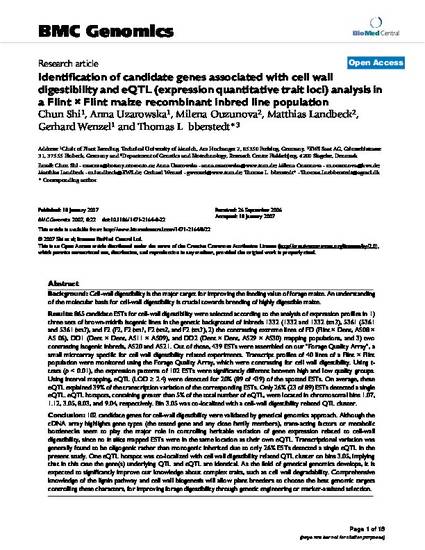
Article
Identification of candidate genes associated with cell wall digestibility and eQTL (expression quantitative trait loci) analysis in a Flint × Flint maize recombinant inbred line population
BMC Genomics
(2007)
Abstract
Background
Cell-wall digestibility is the major target for improving the feeding value of forage maize. An understanding of the molecular basis for cell-wall digestibility is crucial towards breeding of highly digestible maize.
Results
865 candidate ESTs for cell-wall digestibility were selected according to the analysis of expression profiles in 1) three sets of brown-midrib isogenic lines in the genetic background of inbreds 1332 (1332 and 1332 bm3), 5361 (5361 and 5361 bm3), and F2 (F2, F2 bm1, F2 bm2, and F2 bm3), 2) the contrasting extreme lines of FD (Flint × Dent, AS08 × AS 06), DD1 (Dent × Dent, AS11 × AS09), and DD2 (Dent × Dent, AS29 × AS30) mapping populations, and 3) two contrasting isogenic inbreds, AS20 and AS21. Out of those, 439 ESTs were assembled on our "Forage Quality Array", a small microarray specific for cell wall digestibility related experiments. Transcript profiles of 40 lines of a Flint × Flint population were monitored using the Forage Quality Array, which were contrasting for cell wall digestibility. Using t-tests (p < 0.01), the expression patterns of 102 ESTs were significantly different between high and low quality groups. Using interval mapping, eQTL (LOD ≥ 2.4) were detected for 20% (89 of 439) of the spotted ESTs. On average, these eQTL explained 39% of the transcription variation of the corresponding ESTs. Only 26% (23 of 89) ESTs detected a single eQTL. eQTL hotspots, containing greater than 5% of the total number of eQTL, were located in chromosomal bins 1.07, 1.12, 3.05, 8.03, and 9.04, respectively. Bin 3.05 was co-localized with a cell-wall digestibility related QTL cluster.
Conclusion
102 candidate genes for cell-wall digestibility were validated by genetical genomics approach. Although the cDNA array highlights gene types (the tested gene and any close family members), trans-acting factors or metabolic bottlenecks seem to play the major role in controlling heritable variation of gene expression related to cell-wall digestibility, since no in silico mapped ESTs were in the same location as their own eQTL. Transcriptional variation was generally found to be oligogenic rather than monogenic inherited due to only 26% ESTs detected a single eQTL in the present study. One eQTL hotspot was co-localized with cell wall digestibility related QTL cluster on bins 3.05, implying that in this case the gene(s) underlying QTL and eQTL are identical. As the field of genetical genomics develops, it is expected to significantly improve our knowledge about complex traits, such as cell wall degradability. Comprehensive knowledge of the lignin pathway and cell wall biogenesis will allow plant breeders to choose the best genomic targets controlling these characters, for improving forage digestibility through genetic engineering or marker-assisted selection.
Disciplines
Publication Date
2007
DOI
10.1186/1471-2164-8-22
Publisher Statement
This article is published as Shi, Chun, Anna Uzarowska, Milena Ouzunova, Matthias Landbeck, Gerhard Wenzel, and Thomas Lübberstedt. "Identification of candidate genes associated with cell wall digestibility and eQTL (expression quantitative trait loci) analysis in a Flint× Flint maize recombinant inbred line population." BMC genomics 8, no. 1 (2007): 22. 10.1186/1471-2164-8-22. Posted with permission.
Citation Information
Thomas Lubberstedt, Chun Shi, Anna Uzarowska, Milena Ouzunova, et al.. "Identification of candidate genes associated with cell wall digestibility and eQTL (expression quantitative trait loci) analysis in a Flint × Flint maize recombinant inbred line population" BMC Genomics Vol. 8 Iss. 1 (2007) p. 22 Available at: http://works.bepress.com/thomas-lubberstedt/9/
Creative Commons license

This work is licensed under a Creative Commons CC_BY International License.
